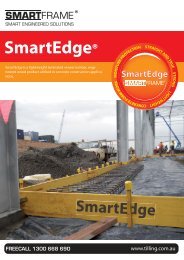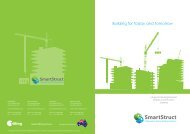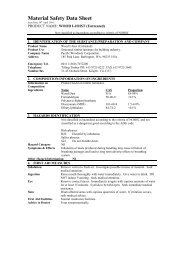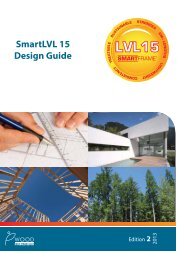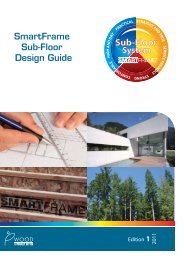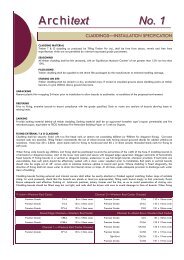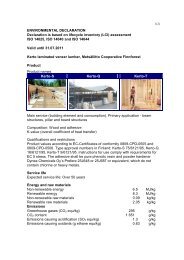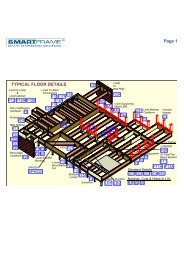SmartJoist Design Guide 2011.pub - Tilling Timber
SmartJoist Design Guide 2011.pub - Tilling Timber
SmartJoist Design Guide 2011.pub - Tilling Timber
Create successful ePaper yourself
Turn your PDF publications into a flip-book with our unique Google optimized e-Paper software.
GENERAL INFORMATION - ABOUT FLOOR PERFORMANCE<br />
The “feeling” that is identified when a person walks on a<br />
floor is very subjective. Some people want to feel a very<br />
stiff floor and others want some ”give” so that it softens<br />
the footing. When people say the floor “bounces”, it may<br />
be vibrating. This sensation is often caused by lack of dead<br />
load such as furniture, direct applied ceilings or other materials<br />
to absorb or dampen the vibration.<br />
The allowable spans shown in the tables of this manual<br />
have been designed to meet the strength and serviceability<br />
criteria in AS1684.1. This standard introduced a further<br />
serviceability equation into the design of floor joists which<br />
checked the deflection caused by a 1.0 kN load applied at<br />
mid-span. If the differential deflection of the joist relative to<br />
an adjacent joist exceeds 2.0 mm then the span is<br />
deemed to be such that the floor performance may be<br />
considered too bouncy for service.<br />
FACTORS THAT CAN AFFECT FLOOR<br />
DYNAMIC PERFORMANCE.<br />
• The choice of flooring system<br />
• The depth, stiffness and mass of the joists<br />
• Spacing of joists<br />
• Fixing of sheathing to joists<br />
• Stiffness and mass of floor sheathing<br />
• Mass and stiffness of ceiling materials<br />
• Method of installation<br />
• Location and type of internal partitions and furniture<br />
FACTORS THAT CAN IMPROVE<br />
FLOOR DYNAMIC PERFORMANCE.<br />
• Glue-nailed floors will perform better than floors secured<br />
by nails alone.<br />
• Deflection of the sheathing material between joists<br />
can be reduced by decreasing the joist spacing or<br />
using a thicker and/or stiffer sheathing.<br />
• Proper installation is essential for dependable performance.<br />
Adequate and level support for the joists is<br />
necessary, as is correct fastening of the joists and<br />
sheathing.<br />
• The installation of a ceiling to the bottom flange of the<br />
joists.<br />
• Between joist blocking can provide some improvement<br />
to floor dynamic performance. It is emphasised that<br />
for between joist blocking to be effective, it is important<br />
that the blocking is continuous, this being<br />
easily achieved by the addition of a continuous bottom<br />
strap such as hoop iron strapping which is also attached<br />
to the end walls.<br />
If floor dynamic performance is a concern to either the<br />
client, designer or contractor, then the above variables<br />
can be altered to improve dynamic performance. Some<br />
stiff floors with very little dead load may tend to vibrate.<br />
This can generally be dampened by directly attaching the<br />
ceiling below the underside of the joists. Where there is no<br />
lining to the underside of the joists, it is recommended<br />
that between joist blocking be utilised to dampen this lightweight<br />
floor.<br />
If between joist blocking is to be used to improve floor dynamic<br />
performance, it is recommended that a blocking<br />
system (at least midspan, ⅓ points for large open rooms)<br />
similar to the one shown below should be adopted.<br />
BETWEEN JOIST BLOCKING FOR <strong>SmartJoist</strong>s<br />
Floor sheeting glued AND nailed<br />
to joists and blocking<br />
<strong>SmartJoist</strong> between joist blocking,<br />
skew nailed with 2.8 x 60 mm nails.<br />
0.91 x 25 mm galvanised mild steel strap<br />
fastened to joists, blocking panels and END<br />
WALLS with 40 x 2.5 mm galvanised nails.<br />
<strong>SmartJoist</strong><br />
floor joists<br />
<strong>SmartJoist</strong> <strong>Design</strong> <strong>Guide</strong> 3




